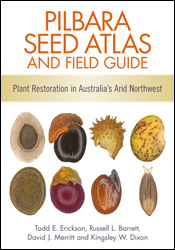Pilbara Seed Atlas and Field Guide
Plant Restoration in Australia's Arid Northwest
Edited by: Todd E Erickson, Russell L Barrett, David J Merritt, Kingsley W DixonIdentifies plant species and provides guidance on seed-based conservation and restoration.
The Pilbara region in Australia’s arid northwest is rich in flora that is suited to extreme temperatures and boom and bust cycles of moisture availability. It is also a region important for its natural resources. In places where mining activities have finished and the land is under management for ecological restoration, there is increasing demand for information about native plant communities and the biology of their seeds. + Full description
Pilbara Seed Atlas and Field Guide is the first book to combine plant identification with robust, scientific criteria for cost-effective seed-based rehabilitation. It describes 103 regional plant taxa and provides guidelines for effective collection, cleaning, storage and germination of their seeds. It addresses issues such as timing of collection, quality and viability of seed, and dormancy release, which are essential for successful restoration programs. With photographs to portray the subtle differences and unique features of each species’ biology, this book will be of great use to practitioners in the field, including environmental consultants, rehabilitation companies, commercial seed collectors and government authorities, as well as naturalists and people interested in growing the Pilbara’s remarkable plants.
- Short descriptionNews
This title is no longer available in print format, but can still be purchased as an eBook.
Reviews
"This book, the first edition of its kind, presents an excellent field guide for the professional restoration ecologist as well as being suitable for the general public interested in plant life of the Pilbara. This latter point is important, as the flora and seed ecology of the Pilbara region are virtual unknowns to the wider public... a compelling educational tool."
Pawel Waryszak, Ecological Management ad Restoration 19(1), January 2018
"The Pilbara Seed Atlas and Field Guide... should be on the bookshelf of every environmental professional who works on ecological management of Pilbara flora... This book provides an impressive summary of information that is incredibly useful for efficiently and effectively using native seeds."
Dr Sean Bellairs, The AusIMM Bulletin, August 2016, p. 90
"The Atlas makes a great field guide because the authors have placed an emphasis on correct identification of both plants and seeds, using excellent photographs, as well as providing details of similar species, and distribution, habitat and flowering time information.
"CSIRO Publishing is to be commended on the high quality design and layout of this book, which is so visually attractive and yet of such scientific and technical accuracy. Highly recommended."
Tony Cavanagh, Growing Australian, September 2016, p. 14
"This book provides a valuable contribution to seed use in the Pilbara and it will appeal to a broad range of people with its universal seed knowledge that can be applied in other ecosystems... Well done to Todd Erickson and his colleagues for providing this beautifully written seed atlas and field guide for the Pilbara region."
Anne Cochrane, Australasian Plant Conservation, November 2016
Details
ePDF | April 2016ISBN: 9781486305537
Publisher: CSIRO Publishing
Available from eRetailers
ePUB | April 2016
ISBN: 9781486305544
Publisher: CSIRO Publishing
Available from eRetailers
Features
- First ever book combining plant identification with detailed information on seed-use
- Combination of themed chapters covering all aspects of seed collection, handling, and germination biology covering a wide range of species from arid systems
- Practitioner focused and designed to be easy to use in the field
- High-resolution images to portray the subtle differences and unique features of each species biology
- Universal seed biology knowledge for use in other ecosystems (e.g. nationally and internationally)
Contents
Foreword from BHP Billiton Iron OreForeword
Contributing authors
Acknowledgements
Chapter 1: Introduction to plant diversity of the Pilbara
Chapter 2: Seed collection, cleaning, and storage procedures
Chapter 3: Seed dormancy and germination of arid zone species
Chapter 4: A systematic approach to seed management for restoration
Chapter 5: An atlas to the plants and seeds of the Pilbara region
Appendix A: Seed dormancy class and suggested dormancy alleviating pre-treatments
Appendix B: Preparation of smoke water and application of aerosol smoke for use as a seed pre-treatment
Appendix C: Checklist of vascular plants in the Pilbara Bioregion
Glossary
Index
Authors
Todd E. Erickson is the Project Manager of the Restoration Seedbank Initiative, a joint project between The University of Western Australia (UWA), Kings Park and Botanic Garden, and BHP Billiton Iron Ore. He has been researching aspects of seed ecology and restoration for over 12 years at the Botanic Gardens of Adelaide, the Department of Parks and Wildlife (Perth), Kings Park and Botanic Garden, and UWA. He completed a PhD in 2015 at UWA researching arid zone seeds and large-scale mining restoration.
Russell L. Barrett worked as a Research Botanist with the Botanic Gardens and Parks Authority prior to moving to the Australian National Herbarium, CSIRO, in Canberra. He is an Adjunct Lecturer at the University of Western Australia in the School of Plant Biology and a Research Associate at the Western Australian Herbarium. He grew up in the remote Kimberley region of northern Western Australia, developing an early passion for plants. An experienced taxonomist and photographer, his work has taken him to many remote parts of the state, discovering many new species of plants along the way.
David J. Merritt is a Senior Research Scientist at Kings Park and Botanic Garden. A seed scientist for more than 15 years, his research interests include seed banking; seed dormancy and germination; and restoration ecology. He completed a PhD in 2002 at The University of Western Australia.
Kingsley W. Dixon is a Professor at Curtin University, Visiting Professor at The University of Western Australia, Visiting Professor at Kings Park and Botanic Garden, Centre Director for the ARC Industrial Transformation Training Centre for Mining Restoration and is the Chair of the Society for Ecological Restoration Australasia. He has programs in native seed biology, ecology, restoration ecophysiology, rare plant conservation, pollination science and marine restoration.








